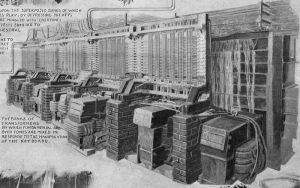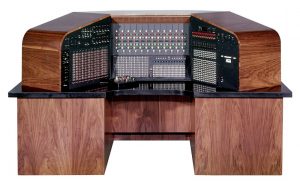Featured Image from: Encyclotronic
The AlphaSphere represents the next step in music evolution: it’s taken electronic music and turned it on its axis, creating a new way of expressing musical creativity.
But none of that would have been possible if it wasn’t for some pioneering musical instruments that were way ahead of its time. From the 1805 instrument Orchestrion, to the 2009 Otomatone, people have always looked for ways to go beyond the regular string, wood, or wind instrument and incorporate technology into music. Here are 10 instruments that are just as unique as the AlphaSphere.
Orchestrion (1805)
 One of the first musical instruments to be powered by electricity, the Orchestrion is a “class” of instruments that mimicked the sound of other instruments. The first Orchestrion was the Panharmonicon, created by Johann Nepomuk Mälzel, a German inventor and good friend of Beethoven. Orchestrions became all the rage in Germany, with companies like Seeburg and Wurlitzer creating bigger and more complex versions of Mälzel’s Panharmonicon. Over the course of a few years, Orchestrions became large machines that incorporated various instruments like pianos, percussions, pipe organs, and violins, among others.
One of the first musical instruments to be powered by electricity, the Orchestrion is a “class” of instruments that mimicked the sound of other instruments. The first Orchestrion was the Panharmonicon, created by Johann Nepomuk Mälzel, a German inventor and good friend of Beethoven. Orchestrions became all the rage in Germany, with companies like Seeburg and Wurlitzer creating bigger and more complex versions of Mälzel’s Panharmonicon. Over the course of a few years, Orchestrions became large machines that incorporated various instruments like pianos, percussions, pipe organs, and violins, among others.
Although mechanical action was used to produce the music, Orchestrions were completely powered by electricity, making them the precursor for electronic music. Many music historians consider these the first jukebox, as Orchestrions became popular in public places like cafes and saloons.
Helmholtz Sound Synthesizer (c. 1890)
Invented by German physicist Hermann von Helmholtz, the Helmholtz Sound Synthesizer was a mechanical wonder of the time, creating sound by via the use of tuning forks and magnets. The Helmholtz Sound Synthesizer was able to copy human voice and the sound of other instruments by manipulating various frequencies and overtones. Using this machine, Helmholtz was able to build upon music theory by showing how the timbre of musical notes was comprised of various other sounds, a concept that can also be applied to language.
Just like the Orchestrion, this is considered to be one of the grandfathers of electronic music, as it produces music electronically. Unlike the Orchestrion, however, the Helmholtz Sound Synthesizer produces the notes without mechanical action, making it one of the first, truly electronic musical instruments.
Telharmonium (1897)

Using electric dynamos (i.e. electric generators), the Telharmonium created music by tuning different sized tone wheels inside its massive frame. Invented in 1897 by American inventor Thaddeus Cahill, the Telharmonium delivered musical tones via telephone lines, and can be modified to reproduce the sound of a full orchestra. The Telharmonium was a hulk of a machine that weighed over 200 tons! While this might usually be a problem, Telharmonium concerts were revolutionary because it could do something that other orchestras could not: broadcast orchestral pieces via telephone.
Only three Telharmoniums were ever created, and sadly, no recordings of it music have survived the times. It is considered to be the world’s first ever synthesizer.
Ondes Martenot (1928)
The Ondes Martenot, invented by French cellist and radio telegrapher Maurice Martenot, created electronic sound via vacuum tube oscillation. Using a keyboard, users of the Ondes Martenot could vary the frequency of the oscillation, thus creating different notes and tunes.
Trautonium (1929)

Reminiscent of a Theremin, the Trautonium was invented by German engineer Friedrich Trautwein in 1929, a year after the patenting of the Theremin. The Trautonium generated sound via frequency oscillations in vacuum tubes, although later models used transistors. Users would play the Trautonium by pressing a resistance wire onto a metal bar, which would modulate the vacuum tubes inside.
Surprisingly, the Trautonium was continually developed and produced until 2002 by Oskar Sala, Friedrich Trautwein’s colleague.
Clavivox (1956)
Patented by American composer Raymond Scott and his then-assistant Robert Moog (who would later on create the well-beloved Moog Synthesizer), the Clavivox was an anlog synthesizer that revolutionized electronic music. The Clavivox had a 3-octave range, with various features like amplitude envelopes, vibrato and other effects.
Raymond Scott continued to develop the Clavivox, eventually adding a photocell to control pitch and timbre.
Electronium (1969)

Also invented by Raymond Scott in 1969, the Electronium was an oddity of a musical instrument: it wasn’t able to play any written music (the unit had no keyboard), however, a user could program it to both compose and play music simultaneously. It was brought by record producer Berry Gordy to Motown Records, and even hired Raymond Scott to run the label’s electronic music division. Although Scott continued to work on the Electronium, it was never fully finished.
Only one Electronium is in existence, and it belongs to Mark Mothersbaugh of DEVO.
Eigenharp (2001)
Marketed as a complete replacement for woodwinds, pianos, and guitars, the Eigenharp was invented by musician John Lambert in 2001. It was created with the purpose of replacing orchestral instruments altogether, all while being more creative and dynamic than conventional electronic music instruments like synthesizers. The Eigenhard uses keys and a breath pipe to control sound, but it’s accompanied by an electronic sequencer that provided the user with samples, effects, and drums.
Zeusaphone (2007)

Known as the Signing Tesla Coils (or, more cheekily, a THORemin) the Zeusaphone is basically a Tesla coil that’s been modified to produce static electricity that has a particular pitch and tone. The plasma outbursts are very much reminiscent of sounds produced by a digital synthesizer. Although Tesla Coil are limited in terms of modulation, simple chords can be reproduced.
Although more of an oddity than an actual instrument, there are now a handful of musicians who use the Zeusaphone as their main instrument.
Otamatone (2009)
Invented by Novmichi Tosa, the Otamatone is more of a meme than a musical instrument. Resembling a musical note with a cartoon face in the bottom, sounds can be manipulated by sliding a finger up and down the note’s body while controlling the “mouth” of the cartoon face.
